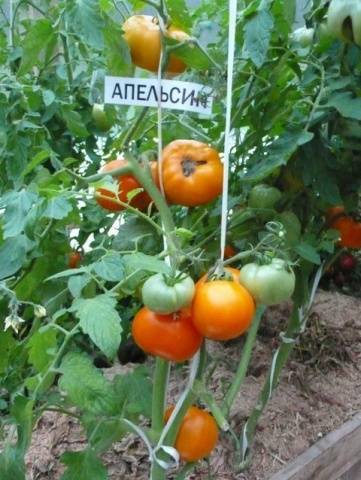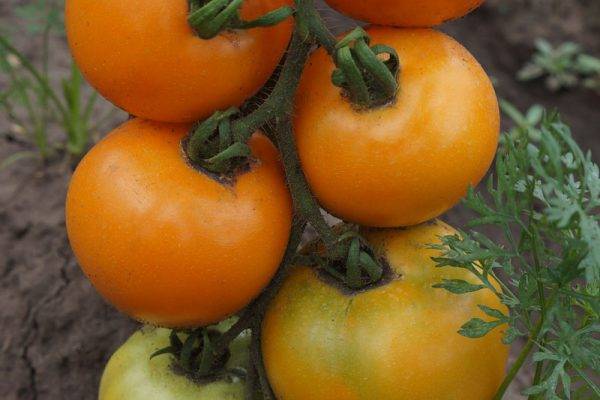Content
Among farmers, there are many fans of yellow tomatoes. The bright color of these tomatoes involuntarily attracts attention; they look good in a salad, and the taste of most varieties is not inferior to the usual red tomatoes. The orange color of the skin also indicates a large amount of carotene, which suggests the additional usefulness of vegetables. All of the above qualities, combined with an excellent appearance, are possessed by the “Orange” tomato variety. A detailed description and characteristics of “Orange” tomatoes can be found later in the article. Surely the information offered will be of interest to novice farmers and experienced farmers who are looking for new tastes.
Description of the variety
The “Orange” tomato variety was bred by Russian breeders in 2000. During cultivation, the tomatoes have proven themselves only from the best side and have earned the respect of many farmers. Today, the Orange variety is widely grown in the central and southern regions of the countries, using greenhouses and open beds for this purpose.For those who are still unfamiliar with Orange, we will try to talk about the external and taste qualities of vegetables, and also give practical advice on growing this variety.
Plant characteristics
The tomato bush of the "Orange" variety is tall and voluminous. The semi-determinate plant actively grows shoots and leaves, which must be removed periodically. The height of the bush reaches 1.5 m. During the growth process, tomatoes should be tied to a reliable stationary support.
The flowers of the variety are simple, collected in brushes of 3-6 pieces. The first flowering raceme is planted above the 7th leaf. It takes a long time for tomatoes to form and ripen, slowing down the fruiting process as a whole. Because of this feature, many farmers prefer to remove the first inflorescence. Higher up the stem, flowering clusters are formed every 2-3 leaves. They quickly form ovaries and produce a harvest.
Fruit characteristics
Variety "Orange" is large-fruited. Its tomatoes weigh about 200-300 g, and in especially favorable conditions the weight of vegetables can reach 400 g. The pulp of tomatoes is very sweet and meaty. It contains 3.2% sugar and relatively high (6.2%) dry matter. When the fruit is cut open, 2-3 chambers filled with some juice and seeds can be seen in the internal cavity.
Orange tomatoes are covered with attractive, bright orange skin with a few longitudinal stripes of yellow.The skin of the vegetable is tender, but at the same time it is able to preserve the integrity of the fruit, protecting it from cracking. You can evaluate the external qualities of vegetables by looking at the photos offered in the sections of the article. Additional comments and reviews about the fruits and plants themselves can be found in the video:
Orange tomatoes with excellent taste and aroma are often consumed fresh. This allows you to emphasize the external qualities of vegetables, preserve their usefulness and aroma. Tomatoes are suitable for dietary and baby food; they can be a good alternative to red vegetables if a person has allergic diseases. Yellow tomatoes can be recommended for people deficient in carotene and vitamins. Vegetables normalize the functioning of the gastrointestinal tract and can also be useful for people with characteristic diseases. Tomatoes are also good in processing. They make delicious, thick tomato juice and sauce. If desired, vegetables can be preserved for the winter.
Crop yield and fruiting period
The ripening of large and juicy tomatoes of the “Orange” variety occurs on average 110 days from the day green shoots appear. Tomatoes ripen gradually, which allows you to constantly remove some vegetables to prepare a fresh salad. Fruiting of the variety continues until the onset of unfavorable weather conditions. In a greenhouse, tomatoes can ripen until November.
The long fruiting period and large-fruited variety allow the farmer to obtain maximum tomato yield. So, from each bush you can harvest more than 4 kg of vegetables per season. Fruit yield per 1 m2 soil is 20 kg.This volume of fruiting allows you to enjoy plenty of tomatoes during the season and prepare them for the winter.
Variety resistance to external factors
Orange tomatoes are thermophilic. They always react vividly to weather changes. In this regard, breeders recommend growing the variety in a greenhouse. Open ground for cultivation can only be used in the southern regions of the country.
The proposed tomato variety has good protection against various diseases characteristic of the crop. However, under certain conditions, “Orange” can be affected by certain ailments, to prevent which it is necessary to provide preventive measures. You can learn more about them from the video:
Various insects and other pests can parasitize tomatoes. To eliminate them, it is also necessary to treat the “Orange” bushes with infusions and decoctions prepared according to folk recipes. Fir paw mulch or special traps can help against slugs and rodents.
Advantages and disadvantages
To objectively evaluate the Orange variety, you need to compare its main advantages and disadvantages. So, the positive qualities of tomatoes are:
- excellent appearance and taste of tomatoes;
- consistently high productivity;
- good disease resistance;
- usefulness of vegetables.
Thus, the external and taste quality of Orange tomatoes is at its best. The disadvantage of the variety is the lack of long-term storage of fresh fruits and the heat-loving nature of the crop. Tall tomatoes can also become a problem for beginning farmers, because semi-determinate bushes require special, careful care and proper formation.
Features of cultivation of the variety
Tomatoes of the "Orange" variety are grown mainly in seedlings. Seeds are sown in containers in the first ten days of March. At the age of 55-60 days, plants are planted in a permanent place of growth. By the time of planting, tomatoes should have 6-9 leaves and a well-developed root system. The height of the seedlings should be within 20-25 cm.
Tomatoes should be planted in open beds and in a greenhouse according to the following scheme: 1 seedling per plot of soil measuring 40x50 cm. After planting, it is recommended to water the bushes and cover the unprotected beds with polyethylene until the onset of consistently warm weather.
The ridges must be regularly weeded and loosened. This will help saturate the tomato roots with oxygen and prevent the development of certain diseases. The formation of bushes involves the removal of stepsons and lower large leaves. The shaping procedure should be carried out in sunny, windless weather so that all wounds heal in time and do not become an “entry gate” for pathogenic fungi.
Fertilizing "Orange" tomatoes should be carried out 3-4 times during the entire cultivation period. Many farmers systematize fertilizing by drawing up the following schedule:
- The first time you need to apply fertilizer 10-12 days after planting the seedlings in a permanent place of cultivation. It is recommended to use rotted organic matter as fertilizer.
- A week after the appearance of the second fruiting cluster, it is necessary to carry out secondary feeding. Complex fertilizer can be prepared from 1 kg of rotted manure, 1 tbsp. l. “Mortar” and copper sulfate with potassium permanganate (3 tbsp each).
- For the third feeding, you should use the same substance as before. Fertilizer should be applied in small quantities during fruit harvesting.
In general, the process of growing tomatoes of the “Orange” variety does not differ significantly from other varieties of the crop. Tomatoes need regular watering and nutrients. The formation of bushes is also a mandatory event. By fulfilling all the basic requirements listed above, even a novice gardener will be able to grow a good harvest of healthy and tasty tomatoes.
Conclusion
Orange tomatoes are an excellent combination of taste, benefits and external qualities. These tomatoes are easy to grow and delicious to eat. They truly deliver aesthetic and gustatory pleasure and are suitable for children and adults, including allergy sufferers. This variety can be recommended to beginners and experienced farmers, because with minimal care, everyone will be able to get the highest quality harvest of good vegetables.















